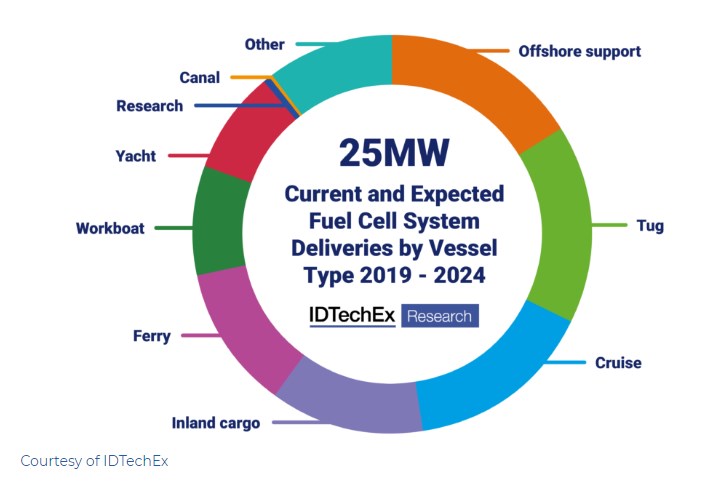

The maritime sector, which accounts for approximately 2.9% of global carbon emissions, is seeking to meet broader climate goals such as the Paris Agreement and ‘Fit for 55’ in Europe, and IDTechEx said it sees green fuels, such as green hydrogen and ammonia, as some of the most promising solutions.
In its report ‘Fuel Cell Boats & Ships 2023-2033: PEMFC, SOFC, Hydrogen, Ammonia, LNG,’ IDTechEx has predicted that green hydrogen proton exchange membrane fuel cell (PEMFC) and LNG/green ammonia solid-oxide fuel cell (SOFC) markets will grow rapidly at 35% CAGR (compound annual growth rate) over a ten-year period.
The company explained that LNG vessels are the largest alternative fuel in marine markets and the global LNG fleet has been growing for decades, driven by an initial policy aimed at reducing localised emissions such as sulfur oxides, nitrous oxides, and particulate matter. However, according to them, the focus is now shifting towards reducing emissions of greenhouse gases, such as carbon dioxide and methane.
Witness to the shift are the new regulations in the maritime sector.
The new International Maritime Organisation (IMO) policy includes an ‘Energy Efficiency Existing Ship Index (EEXI),’ which ensures a ship is taking technical steps, in terms of how it is equipped and retrofitted, to reduce greenhouse gas emissions, and the Carbon Intensity Indicator (CII), a measure of the carbon emissions per amount of cargo carried per mile, targets reducing emissions operationally.
These measures are expected to become mandatory from 2023, with the first ship ratings given in 2024.
IDTechEx said the new regulations undermine LNG use as a long-term solution because of methane slip, which occurs at every step in LNG’s lifecycle, alongside energy-intensive cooling (–161C) and re-gassing requirements, but will create opportunities for alternative fuels, including green hydrogen, green ammonia, or e-fuels combined with carbon capture.
Currently, there are two main options for fuel cells in the marine environment, PEMFC, using green hydrogen, and SOFC, which are fuel flexible but notably can run on green ammonia, a derivative of green hydrogen.
PEMFC’s high-power density and ambient temperature operation make them suitable across various transport applications.
Marine PEMFC suppliers include Nedstack, Powercell, and Ballard.
IDTechEx noted that, while none of the companies began supplying fuel cells to the marine sector, all have begun to pivot to the sector as opportunities have been created by regulation and funding.
It added that innovations from those companies are also driving sales, with recent products greatly increasing power density and safety. Improvements include the use of novel stainless steel plate materials alongside double-walled hydrogen pipes, ventilation fans, and hydrogen sensors, allowing the fuel cell to be installed within the ship rather than on the open deck.

According to the project database tracked by IDTechEx in ‘Fuel Cell Boats &Ships 2023-2033: PEMFC, SOFC, Hydrogen, Ammonia, LNG,’ the average system size per vessel has now jumped to over 1 MW.
Currently, end-use is dominated by a few large systems in inland cargo vessels, workboats, offshore support vessels (OSVs), tugs, cruise ships, and ferries, the company said.
Amongst the largest orders are a 3.2 MW PEMFC system from PowerCell, a 2 MW SOFC system from Alma Clean Power, and individual 2 MW PEMFC orders for the H-Tug and Ulstein OSV to be delivered by Nedstack.
IDTechEx concluded that it expects that for now most orders will use PEMFC technology and remain in inland and coastal sectors (due to the volumetric limits of hydrogen). However, it also predicts that repeat orders are poised to drive rapid market growth.